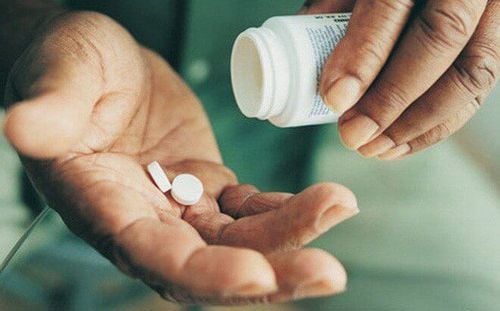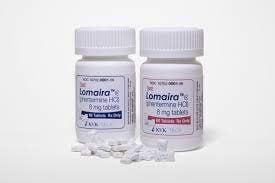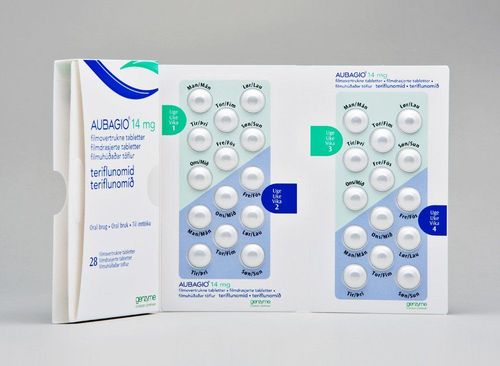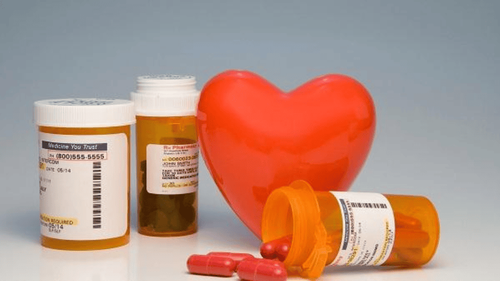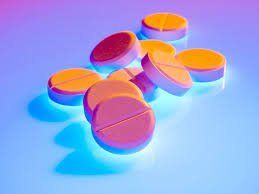This is an automatically translated article.
The article was professionally consulted by Specialist Doctor II Nguyen Quoc Viet - Department of Medical Examination & Internal Medicine - Vinmec Da Nang International General Hospital. The doctor has more than 20 years of experience in the examination and treatment of cardiovascular diseases and Cardiovascular Interventions (Including angiography, dilation, stenting of coronary arteries, renal arteries...), placing temporary pacemakers , forever...1. Overview of hypertension
1.1 What is blood pressure? When the heart contracts, blood is pumped, pressed against the vessel wall, stretching the vessel wall. The force on the walls of the blood vessels as blood is pumped by the heart into the arteries is called the systolic pressure. After contraction, the heart will relax, the vessel wall will return to its original state. The force of blood against the vessel walls as the heart relaxes is called diastolic pressure.Normal blood pressure measured in the arm is less than 120/80 mmHg (90/60mmHg ≤ BP ≤ 140/90mmHg) for adults.
1.2 What is hypertension? Normally, blood pressure can vary within certain limits due to a number of factors. However, if blood pressure is frequently higher than normal during both the contraction of the heart (systole) and the relaxation of the heart (diastole), it is called hypertension. When a person is said to have hypertension when the blood pressure is 140/90 mmHg or higher, the measurement is repeated several times. High blood pressure can cause many dangerous complications such as heart failure, cerebrovascular accident, leading to disability or death.

Eating and exercising are important in the treatment and prevention of complications of high blood pressure. In mild cases of high blood pressure, just adjusting the diet and increasing exercise can significantly improve the condition. For more severe cases of hypertension, a reasonable change in diet and exercise is a mandatory treatment that needs to be combined with drug treatment.
2. High blood pressure should eat what?
A high sodium diet causes high blood pressure. According to many studies, a diet that is limited in sodium, rich in potassium, calcium and magnesium, limits alcohol, does not smoke, consumes food with a moderate amount of energy, ... can control mood. mild hypertension and improve prognosis for severe hypertension. At the same time, it is necessary to manage the patient's weight well, if obese, it is necessary to implement scientific weight loss methods.2.1 About nutritional composition It is necessary to maintain a diet that provides enough energy, vitamins and minerals for the body, low in sodium, rich in potassium and fiber, and reduces the amount of saturated acid. The appropriate nutritional composition for the patient is:
Energy requirement: 30 - 35 Kcal/kg body weight/day; Protein: 15 - 20% of total energy; Lipids: 20 - 25% of total energy; Glucid: Has the right ratio to total energy; Amount of dietary fiber: About 14g/1000kcal; Amount of sodium provided: 1600 - 2000mg/day; Provide adequate vitamins and minerals, especially vitamin B6, vitamin B12, folic acid, vitamin D.
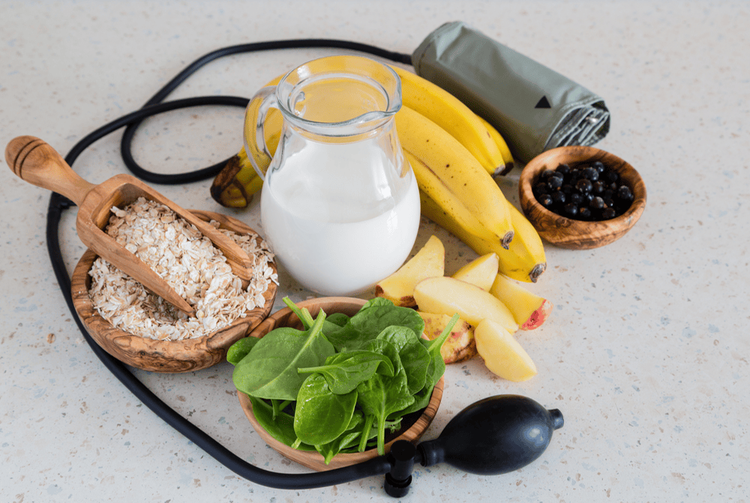
Adopt a diet rich in green vegetables, ripe fruits and low-fat dairy products; Eat lightly: The daily amount of salt that an adult needs is 10-15g. For people with high blood pressure, it is necessary to maintain a low-salt diet, with no more than 6g of salt per day. The reason is because if you eat a lot of salt, sodium ions will be transferred more to the smooth muscle cells of the vessel wall, increasing the water inside the cells, increasing the vascular tone, leading to vasoconstriction, increasing peripheral resistance and increasing blood pressure. pressure; Potassium-rich diet: About 50 - 90mmol/day. Potassium plays an important role in metabolic processes inside cells. If the concentration of potassium in the body is increased, it can decrease the concentration of sodium, increase the excretion of sodium from the body. Therefore, a diet rich in potassium helps to support the treatment of hypertension and control blood pressure in hypertensive patients. Vegetables, rice and potatoes are rich sources of potassium, should be supplemented for patients with hypertension; Diet rich in magnesium: Adults need 500mg/day, pregnant women need 925mg/day, lactating women need 1250mg/day and children under 3 need 140mg/day. Magnesium plays an important role in regulating the excitability of the nervous system, helping to combat spasticity and vasodilation, and support the treatment of hypertension. People with high blood pressure can supplement magnesium in the body through soybeans, wheat, rice,...; Adding calcium to the diet: It is necessary to meet the calcium requirement of children 0 - 1 year old is 500 - 600mg/day, from 19 years old and older need 400 - 500mg/day, pregnant and lactating women is 1000 - 1200mg/day. Eating more calcium-rich foods may help lower blood pressure in people with salt-sensitive hypertension. Normally, calcium is absorbed about 30-40% from the diet. Lactose in milk and vitamin D can increase the body's ability to absorb calcium; Eat healthy fats: Fish, seafood, fish oil, vegetable oils, sunflower seeds, almonds,... Diet rich in fiber: People with high blood pressure should adhere to a diet rich in green vegetables. , fruits, raw grains, legumes,... Fibers have the ability to absorb water and swell to 8 - 10 times their original weight, helping to bind and eliminate many residues and substances. toxic out of the body. At the same time, fiber also attracts bile acids secreted by the body to digest fats and excrete them out. This stimulates the body to mobilize cholesterol stored in the liver to produce bile acids, reducing blood cholesterol; Diet rich in vitamins C and E: Vitamin C helps to reduce cholesterol, increase the elasticity of blood vessels; Vitamin E helps to prevent oxidation, ensure the completeness of cell membranes and prevent hardening of the arteries. As a result, these two vitamins help prevent high blood pressure, high blood fat, coronary heart disease,... Drink lots of water: purified water, lotus tea, corn silk juice, boiled vegetable juice,... 2.3 What are the dietary restrictions for high blood pressure? Coffee: May increase blood pressure acutely; Alcohol: Men should only drink no more than 2 small glasses of wine per day (about 30ml) and women should only drink no more than 1 small glass of wine because drinking a lot of alcohol can cause cardiovascular disorders, high blood pressure, and high blood pressure. Stroke; Animal fat: Because animal fat increases cholesterol in the blood, causing atherosclerosis, high blood pressure; Processed foods, fried foods, sweets; Do not smoke because nicotine causes peripheral vasoconstriction, causing an increase in blood pressure.
3. How to exercise with high blood pressure?
Appropriate exercise and sports is one of the effective ways to treat high blood pressure without drugs. The principle of this method is to help regulate blood cholesterol, control atherosclerosis, dilate and increase the elasticity of blood vessels, reduce peripheral blood resistance, thereby reducing blood pressure.
Details of the two exercises are as follows:
Brisk walking Depending on the health condition, the patient can walk briskly at different speeds. If you walk at a speed of 5-6km/h, your heart rate can reach about 100-110 beats/min during exercise. A patient should practice 5-7 times a week, each session time from 40-60 minutes will give good results. When you are familiar with the exercise, it is necessary to gradually increase the intensity of movement by switching to running small steps to improve fitness and maintain training efficiency.
Run small steps For those who are just starting to practice running, in the first sessions (the first 8-12 weeks) should run at a low speed so that the body has time to gradually adapt to the amount of movement. During this time, the patient can alternate exercises between walking and running until the body can maintain a continuous running intensity. In hypertensive patients, it is recommended to maintain a running speed of about 7 - 8 kgm/hour depending on the state of health. The patient's heart rate can reach about 120-130 beats/min during exercise. When getting used to the intensity of exercise, patients need to increase the running time to 20-30 minutes/session, regularly exercise at least 3-4 times/week.
Note:
For patients with high blood pressure over 160/90mmHg, it is recommended to combine strength training with the use of antihypertensive drugs (should take the drug 15-30 minutes before exercise or follow the instructions of the doctor). doctor); Patients under 45 years of age, with grade I hypertension (140/90 - 160/95mmHg) with the possibility that blood pressure can return to normal without medication, can apply exercise on a dynamometer. at home; Patients with grade III hypertension (above 180/110 mmHg) need to take medication to control blood pressure, then exercise with brisk walking exercises at a speed of 3-5km/h, 20 - 30 minutes/day, combined with breathing exercises. After a week of getting used to the exercise, it is possible to increase the speed or distance of walking. If you have symptoms of heart failure, do not exercise, just go for a walk and breathe fresh air; You can choose other exercises such as swimming, meditation, yoga, tai chi,... suitable for your age, disease level and health condition; The principle of practice is regular, continuous and gradually increasing the time and speed of the exercise. Patients should maintain a regular exercise regimen of at least 30-45 minutes/day and most days of the week; Patients need to persevere in exercise because usually after 2-3 months of regular exercise, blood pressure begins to drop; Warm up before exercise and relax after exercise to avoid injury and give the body time to balance blood pressure; Breathe evenly and deeply during exercise. Holding your breath or breathing irregularly can raise blood pressure and cause muscle pain; Stop exercising when there are symptoms: Dizziness (due to exercising too hard, not eating enough before exercise), sudden shortness of breath (may be due to asthma or heart attack),... Patients with high blood pressure should implement and cooperate with the doctor in adjusting the diet and exercise to minimize the complications of the disease, ensure good health and prolong life, avoid complications.
One of the safest and most accurate ways to know your blood pressure is to have your blood pressure checked at a hospital with a reputable cardiologist. The basic hypertension package deployed at Vinmec International General Hospital is the first choice for people at risk of high blood pressure or showing signs of hypertension. The examination package will help determine the causes, complications and levels of hypertension, help patients understand their health status and promptly take necessary interventions.
Please dial HOTLINE for more information or register for an appointment HERE. Download MyVinmec app to make appointments faster and to manage your bookings easily.
Recommended video:Things to know about high blood pressure
SEE MORE:
How dangerous is high blood pressure during pregnancy? Basic hypertension checkup package Recognizing signs of high blood pressure in children





